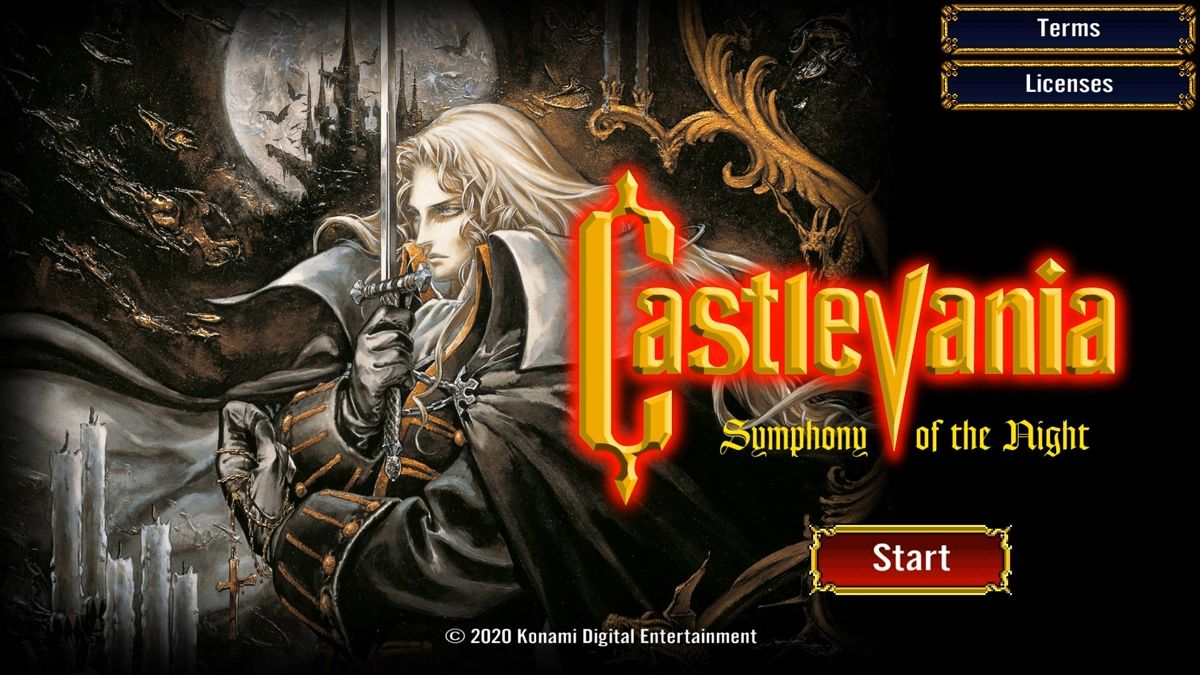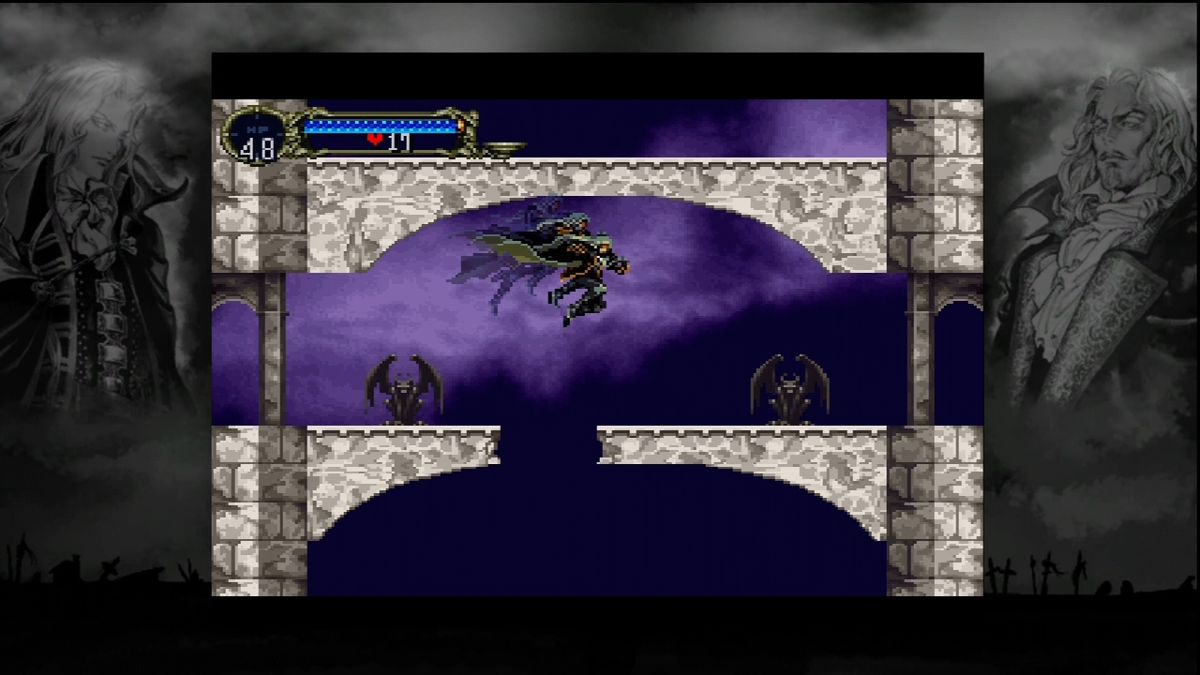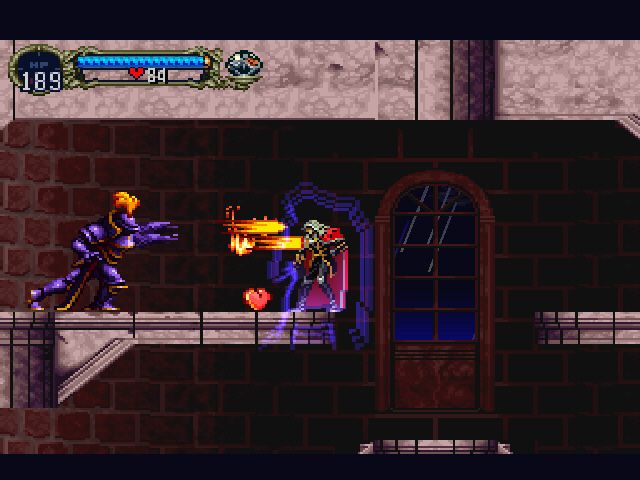Retro Replay Review
Gameplay
Castlevania: Symphony of the Night redefined the series by marrying classic platform action with deep RPG mechanics. Instead of the strictly linear progression of earlier titles, the game offers a sprawling, labyrinthine castle to explore at your own pace. Secret rooms beckon with hidden treasures, and progression often hinges on locating items—double jumps, mist form, or elemental shields—that unlock new paths. This “Metroidvania” approach keeps the experience fresh as you toggle between combat, exploration, and backtracking to discover previously inaccessible areas.
(HEY YOU!! We hope you enjoy! We try not to run ads. So basically, this is a very expensive hobby running this site. Please consider joining us for updates, forums, and more. Network w/ us to make some cash or friends while retro gaming, and you can win some free retro games for posting. Okay, carry on 👍)
The RPG elements are woven seamlessly into the action. Defeating enemies grants experience points, so Alucard levels up, boosting health, strength, and defense. You’ll gather money and a plethora of accessories—rings, cloaks, gauntlets—to fine-tune your build. A separate equipment screen lets you manage sub-weapons (axes, holy water, boomerangs), primary weapons (swords, spears, shields), and relics that bestow passive bonuses. With dozens of spells and “special moves” executed via directional and button combinations, the combat system is surprisingly deep and rewarding, especially when unleashing a spiral sword attack or summoning familiars for backup.
Different versions of the game introduce subtle tweaks to gameplay. The Sega Saturn edition adds the Underground Garden and Haunted Path, plus a fully playable Maria Renard, expanding variety and replayability. However, it sacrifices certain transparency effects found on the PlayStation original. Later ports on iOS and Android (via Dracula X Chronicles) include Saturn familiars and items, marrying the best of both worlds. No matter your platform, Symphony of the Night’s responsive controls and meticulously designed enemy encounters make every delve into the castle a joy.
Graphics
Symphony of the Night showcases some of the finest 2D sprite work on the original PlayStation. Each character sprite is richly detailed, from Alucard’s flowing hair and cape to the grotesque beauty of the castle’s denizens—be they armored knights, giant bats, or eldritch horrors. Backgrounds are layered with parallax scrolling, giving depth to vast halls, torchlit corridors, and moonlit courtyards. The gothic art direction captures the haunting elegance of Dracula’s domain, balancing foreboding architecture with ornate flourishes.
The PlayStation version leverages transparency effects for water, mist, and spectral enemies, adding atmosphere and polish. By contrast, the Sega Saturn release, while introducing new zones, forgoes some of these effects—a trade-off for exclusive content. Recent mobile ports based on the Dracula X Chronicles build restore familiars and items but maintain the PS1’s visual clarity rather than the Saturn’s filtering. Across all versions, the game’s palette and animation frames hold up remarkably well, and modern displays often benefit from upscaling filters or scanline options to preserve pixel-perfect detail.
Boss designs are standout highlights, each confrontation feeling like a set piece. From the colossal stone gargoyles in the Castle Keep to the crystalline nightmare of the inverted clock tower, every monster and mechanoid oozes personality. Animations—sword slashes, whip cracks, spell castings—are fluid, with impacts landing with satisfying visual feedback. Even after decades, Symphony of the Night’s sprite artistry remains a benchmark for 2D action games, evoking both nostalgia and awe in new players.
Story
Set five years after Richter Belmont’s harrowing victory over Dracula, the narrative of Symphony of the Night hinges on the sudden disappearance of the legendary Vampire Hunter. Dracula’s castle mysteriously reemerges, and Maria Renard—now grown and determined—ventures into its depths seeking her friend and mentor. Meanwhile, Alucard, the dhampir son of Dracula, awakens from eternal slumber, drawn by the upheaval in his father’s realm. The intertwining quests of Maria and Alucard provide both context and motivation, even if much of the storytelling unfolds through environmental cues and brief dialogue interludes.
>p>Unlike other games heavy on cutscenes, Symphony of the Night lets the castle itself tell the tale. Hidden chambers contain inscriptions about Dracula’s power, while elaborate set pieces—like the inverted castle swimming above your head—underscore the supernatural stakes. Character moments, such as Maria’s playful banter or Alucard’s brooding reflections, add emotional weight to the journey. The game culminates in multiple endings based on specific criteria: freeing Richter, confronting the true mastermind, or simply escaping with your life. These branching outcomes reward thorough exploration and fuel replayability.
For long-time fans, Symphony of the Night pays homage to Rondo of Blood with nods to familiar faces and plot threads, yet it stands as its own compelling chapter. Alucard’s internal conflict—torn between his bloodline and the desire to stop his father—injects tragic gravitas. Maria’s hopeful determination contrasts sharply with the castle’s oppressive gloom, forging a balance of light and dark. The storyline may be simple on the surface, but its execution and the sense of discovery it fosters make it memorable.
Overall Experience
Castlevania: Symphony of the Night remains a cornerstone of 2D gaming more than two decades after its debut. Its blend of tight action, deep RPG progression, and sprawling non-linear map set a template that many modern “Metroidvania” titles still follow. Whether you’re a completionist hunting every secret or a newcomer eager to experience a landmark title, the castle’s myriad rooms, boss gauntlets, and hidden bosses provide hours of content.
Modern re-releases and ports offer quality-of-life improvements—quick saves, improved frame rates, and touchscreen or remappable controls—without diluting the core experience. The haunting soundtrack by Michiru Yamane, featuring baroque organ, choral vocals, and driving rock beats, underscores every corridor and castle wing. Together with the atmospheric visuals and inventive level design, the audio-visual package is timeless.
Ultimately, Symphony of the Night is more than a nostalgic relic; it’s a masterclass in game design that still influences developers today. Whether you’re playing the original PlayStation release, the Saturn version with extra zones, or a portable adaptation on mobile or handheld, you’re getting one of the most polished, engaging experiences in the series. For anyone seeking epic gothic adventure, deep customization, and a vast, living world to explore, Castlevania: Symphony of the Night is an essential purchase.
 Retro Replay Retro Replay gaming reviews, news, emulation, geek stuff and more!
Retro Replay Retro Replay gaming reviews, news, emulation, geek stuff and more!









Reviews
There are no reviews yet.